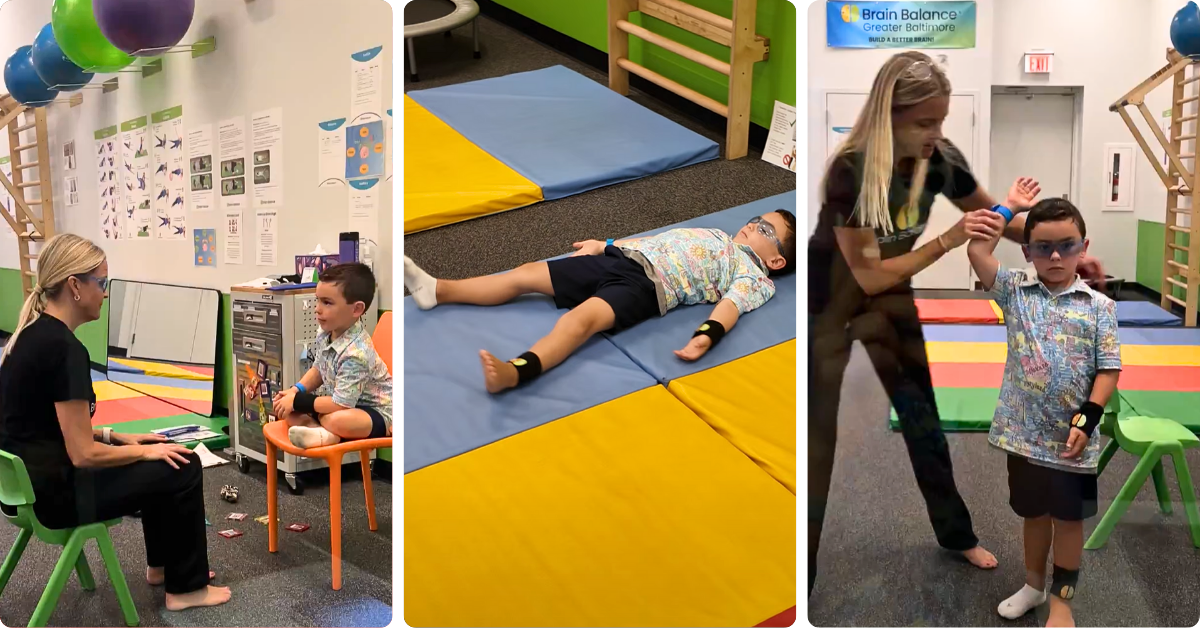Back to School, Back to Balance: How We’re Seeing Results with Brain Balance of Greater Baltimore
Helping kids thrive this school year by building routines, balancing screen time, and strengthening executive function.
When September rolls around, there’s something about the back-to-school season that always feels like a reset button. Fresh backpacks, sharpened pencils, and new routines give us all a sense of possibility. But if you’re a parent, you also know it can bring a lot of challenges, especially if your child struggles with focus, transitions, or managing big emotions.
For us, this year feels different. Since my son Grant started the Brain Balance program nearly three months ago, I’ve noticed subtle but powerful shifts that are already changing how we handle school, screens, and daily life at home. As we move into month number two of the school year, I’m realizing just how much more hopeful, and more equipped, I feel compared to years past.
Why Executive Function Matters for School
One of the things I’ve learned through Brain Balance is just how important executive function skills are for kids. These are the brain-based abilities that help kids stay organized, manage time, remember directions, and regulate emotions, basically, all the things school demands every single day.
For Grant, this was an area of struggle. Mornings could feel chaotic, homework time overwhelming, and transitions like “time to turn off the TV” often ended in meltdowns. I used to think he was just being “difficult,” but Brain Balance helped me see it differently: his brain wasn’t wired to handle these demands yet.
Through sensory-motor activities, cognitive exercises, and nutrition guidance, Brain Balance is designed to strengthen these exact skills. And while we’re still early in the journey, I’m already noticing small wins: smoother mornings, less resistance when we shift between activities, and more confidence in the classroom setting.
Balancing Screen Time in a Digital World
Like most families, we battle the screen time struggle. Between TV, tablets, and video games, it sometimes feels like screens are everywhere, and kids naturally gravitate toward them.
But one of the most eye-opening parts of this journey has been learning how screen time impacts the brain, especially for kids with sensory or attention challenges. Excessive screens can overstimulate the nervous system, affect sleep, and even make it harder for the brain to integrate primitive reflexes.
At home, we’ve started making some changes inspired by Brain Balance and resources like the Digital Well-Being Action Plan. Here’s what’s working for us:
Green time before screen time: We try to get outside, move, or play before turning on any devices. It helps regulate energy and mood.
Digital sunsets: Screens go off at least an hour before bedtime to protect Grant’s sleep.
Family tech agreements: We set shared rules about when and how we use screens, and yes, parents are part of this too!
Are we perfect at this? Definitely not. But even small changes have made evenings calmer and mornings less groggy.
Creating Predictable Routines
Brain Balance has taught me that kids thrive on predictability and rhythm. At first, I thought we had a decent routine, but I’ve realized how much consistency matters, especially for kids who struggle with transitions.
Here’s what’s changed at our house:
Morning checklists: A visual list that Grant can follow for getting dressed, brushing teeth, and packing his bag.
After-school wind-down: Instead of jumping straight into homework or screens, we start with movement (bike rides, trampoline, or Brain Balance exercises).
Bedtime rhythms: Same order every night, bath, story, snuggles, lights out.
It sounds simple, but it makes such a difference. And honestly, it’s helped me as much as it’s helped Grant.
Nutrition Tweaks That Support Focus
If you’ve been following along since July’s blog, Why We Said Yes to Brain Balance, you know I was especially intrigued by the nutrition piece of the program. In August, I shared What We’re Doing Differently at Home Thanks to Brain Balance, including how we’ve started shifting toward more whole foods, balanced meals and reducing gluten.
This month, I’ve noticed how much these small nutrition shifts are helping during school days. Protein at breakfast keeps Grant focused longer, and limiting sugar in his lunchbox avoids the mid-afternoon crash. It’s not about being perfect, but about making intentional choices that support his brain and body.
Celebrating Small Wins
One of the best lessons Brain Balance has taught me is to celebrate progress, not perfection. Instead of focusing on what’s still hard, I’m learning to notice the little wins:
Grant finishing his morning routine without reminders.
A smoother transition from iPad time to dinner.
A calmer reaction when homework feels overwhelming.
These may sound small, but together, they paint a picture of growth. And that’s exactly what keeps me motivated to stick with the program, because the progress is real.
Why This Matters for Families
The back-to-school season can feel overwhelming, especially if your child struggles with focus, behavior, or emotional regulation. What I’ve discovered through Brain Balance is that there’s hope, and there are tools we can use at home to make things smoother.
By combining Brain Balance’s center-based work with changes in our routines, screen time habits, and nutrition, our family is building new patterns that feel more sustainable and connected.
And perhaps the most important part? Grant is starting to feel more confident in himself. That’s a gift no program can promise, but one I’ll never stop being grateful for.
Ready to Learn More?
If you’ve ever wondered if there’s something more you could be doing for your child, I encourage you to explore Brain Balance Columbia. Whether your child has a diagnosis like ADHD, sensory processing disorder, or simply struggles with focus and regulation, this program could be the missing piece.
Start with a consultation or schedule an assessment to better understand your child’s unique brain-body connection.
And if nothing else, follow along with us here on The Columbia Mom. I’ll continue sharing our journey, the challenges, the breakthroughs, and everything in between, so that other families know they’re not alone.
Here’s to a school year filled with more balance, more growth, and more hope.

